
Have you ever paused to consider how much power your subwoofer consumes? Whether you’re a music enthusiast or a home theater aficionado, the subwoofer plays a pivotal role in enriching your audio experience with deep, resonant bass. But, this immersive sound comes at a cost – power consumption.
In this article, we’ll dive into the specifics of How Much Power Does Subwoofer Use, shedding light on the various aspects that influence its energy usage.
From understanding the basics of power consumption to exploring the types and efficiency of subwoofers, we aim to equip you with knowledge to make informed decisions about your audio setup.
Let’s embark on this enlightening journey together, discovering how to enjoy the booming bass without breaking the bank on your electricity bill.
- Understanding Subwoofer Power Consumption
- How Much Power Does Subwoofer Use?
- Types of Subwoofers and Their Power Needs
- Measuring Subwoofer Power Usage
- Factors Affecting Subwoofer Power Consumption
- How to Calculate the Cost of Running a Subwoofer?
- Tips for Reducing Subwoofer Power Consumption
- Conclusion on How Much Power Does Subwoofer Use
- FAQs: How Much Power Does Subwoofer Use
Understanding Subwoofer Power Consumption
When we talk about power consumption in the context of subwoofers, we’re essentially asking, How much electricity does this device use to give us those deep, thrilling bass sounds? It’s a bit like finding out how much fuel a car needs to run—only here, we’re measuring in watts instead of gallons.
Several factors play a big role in how much power a subwoofer uses. Let’s break these down into bite-sized pieces so we can understand them better:
Size Matters
First up is size. Just like with cars, bigger subwoofers generally need more power to operate. That’s because larger subwoofers have bigger drivers (the part that moves to create sound) that need more energy to produce those low-frequency sounds we love.
Type of Subwoofer
Next, we have the type of subwoofer. There are mainly two types: active (powered) and passive (unpowered).
Active subwoofers have their own built-in amplifier to power the driver, which means they pull more electricity directly from your outlet.
Passive subwoofers, on the other hand, rely on an external amplifier to get their power, affecting the overall power usage differently.
Efficiency is Key
Finally, efficiency plays a huge part. This is all about how well a subwoofer converts electrical energy into sound. Some subwoofers are designed to be more efficient, meaning they use less power to produce the same amount of sound as less efficient models. Think of it as getting more bang for your buck—or in this case, more bass for your watt.
Understanding these factors can help you make smarter choices about which subwoofer to bring into your home. Whether you’re setting up a new home theater or upgrading your music system, knowing about power consumption can save you money on electricity bills and ensure you’re getting the best performance for your power.
How Much Power Does Subwoofer Use?

If you’re curious about the energy footprint of your home audio system, particularly how much power a subwoofer uses, you’re in the right place.
The power consumption of a subwoofer can vary widely based on its design, efficiency, and how loudly you like your bass. Let’s simplify this to get a clearer picture.
Power Ratings: RMS and Peak Power
Subwoofers typically have two power ratings: RMS (Root Mean Square) and peak power.
RMS power indicates the average power a subwoofer uses during normal operation, while peak power reflects the maximum power it can use in short bursts.
RMS power is a more realistic measure of a subwoofer’s power consumption. These ratings can range from as low as 50 watts to as high as 1000 watts or more for high-performance models.
Active vs. Passive Subwoofers
Remember, active (powered) subwoofers have built-in amplifiers, which consume additional power. Passive (unpowered) subwoofers, requiring an external amplifier, might seem to use less power on their own, but you must consider the total power usage of both the subwoofer and the amplifier for an accurate measure.
Average Power Usage
On average, a home subwoofer might use anywhere from 100 to 500 watts of power under normal listening conditions. However, this number fluctuates based on how loudly you play your music or movies and the subwoofer’s efficiency. High-efficiency models can produce the same volume using less power.
Calculating Electricity Cost
To understand the impact on your electricity bill, you can use a simple formula: multiply the subwoofer’s average power usage (in watts) by the number of hours you use it. Then, divide by 1000 to convert to kilowatt-hours (kWh), the unit of energy your electricity company uses to bill you.
For example, if you have a 200-watt subwoofer and use it for 2 hours a day, the calculation would be: Power Usage=200 watts×2 hours/1000 = 0.4 kWh/day
Multiply this by the number of days you use your subwoofer in a month, and then by the cost per kWh on your electricity bill, to find out how much it adds to your monthly expenses.
Types of Subwoofers and Their Power Needs
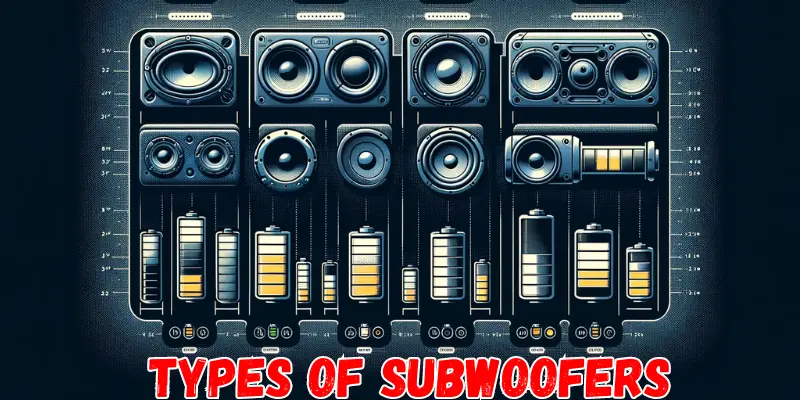
When we dive into the world of subwoofers, we quickly find out that not all subs are created equal—especially when it comes to their power needs.
Understanding the differences between active and passive subwoofers, as well as the impact of their design (like ported, sealed, or bass reflex) on power consumption, can help you make a savvy choice for your audio system. Let’s chat about these differences and what they mean for you.
Active vs Passive Subwoofers
First off, let’s talk about active (powered) and passive (unpowered) subwoofers.
Active subwoofers have a built-in amplifier, which means they’re pretty much plug-and-play. They draw power directly from your electrical outlet to power the amplifier.
On the flip side, passive subwoofers rely on an external amplifier. This setup means the power usage depends not just on the subwoofer itself but also on the external amp you’re using.
So, if you’re looking for simplicity and don’t mind the extra power usage, an active subwoofer might be your best bet. But if you love customizing your audio setup and have a handle on how amplifiers work, a passive subwoofer could be more your style.
Impact of Design on Power Consumption
Now, let’s touch on how different designs affect power needs. Subwoofers come in various designs, including ported, sealed, and bass reflex, each with its own impact on power consumption:
Sealed Subwoofers:
These are the simplest designs, with a completely enclosed space behind the driver. They’re known for tight, accurate bass and generally require more power to produce the same level of loudness as other types because they don’t have the additional boost of air pressure from a port or vent.
Ported and Bass Reflex Subwoofers:
These designs have a hole (port) or system (bass reflex) that allows air to move in and out. This movement helps to amplify the bass output without needing as much power from the amplifier. They’re great for getting more volume out of less power, making them efficient choices if you love feeling the rumble of deep bass.
Choosing the right subwoofer involves balancing your desire for power efficiency with the type of bass experience you’re looking for.
Whether you lean towards the plug-and-play convenience of an active subwoofer or the customizable nature of a passive one, or if you’re weighing the efficiency of ported versus the precision of sealed designs, knowing these basics can guide you to the perfect bass companion for your audio system.
Measuring Subwoofer Power Usage
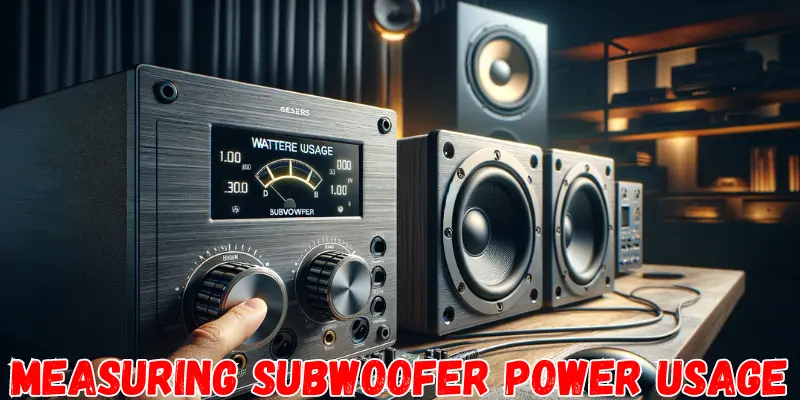
Understanding how much power your subwoofer consumes is crucial, not just for your electric bill, but also for ensuring you’re getting the most out of your audio setup. Let’s break down how power consumption is measured and how you can track it yourself.
How Power Consumption is Measured?
Power consumption for subwoofers, like all electronic devices, is measured in watts. When looking at subwoofer specs, you’ll often come across terms like RMS power and peak power:
Finding Power Consumption Information
Manufacturers usually list the RMS power in the subwoofer’s specifications, but finding the exact power consumption can sometimes be tricky. Here’s how you can get this information:
Tools for Measuring Real-Time Power Use
For those of us who love to see the numbers ourselves, there are tools to measure your subwoofer’s power usage in real-time:
Using these tools and tips, you can get a clear picture of your subwoofer’s power consumption. This knowledge not only helps you understand your subwoofer’s efficiency but also empowers you to make energy-conscious choices, ensuring your love for deep bass doesn’t have to mean a deep dive into your wallet for the electricity bill.
Factors Affecting Subwoofer Power Consumption
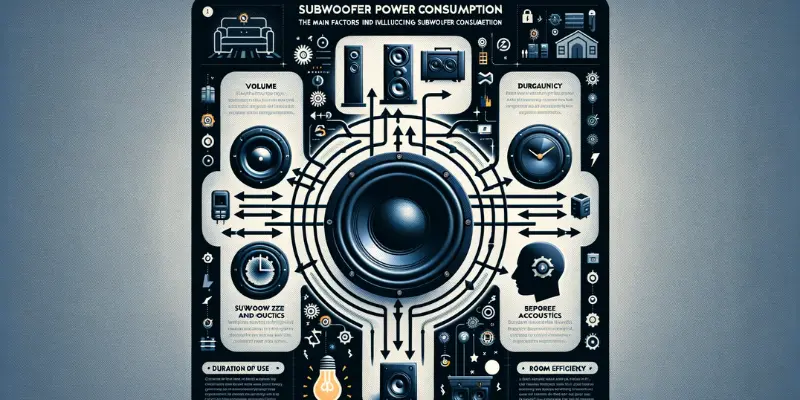
When it comes to the power consumption of your subwoofer, several factors come into play, shaping just how much energy this essential component of your audio system uses.
Understanding these factors can help you optimize your subwoofer’s performance without unnecessarily ramping up your electricity bill. Let’s dive into what influences subwoofer power usage and how you can manage it.
Usage Patterns: Volume and Duration
The way you use your subwoofer has a significant impact on its power consumption. Two critical aspects of usage patterns are volume and duration:
The Role of Subwoofer Efficiency
Subwoofer efficiency is all about how well the device converts electrical energy into sound energy. A more efficient subwoofer uses less power to produce the same volume of sound compared to a less efficient one.
This efficiency is often related to the subwoofer’s design and the materials used in its construction. When choosing a subwoofer, looking for models that highlight their efficiency can lead to savings on your energy bills in the long run.
Room Size and Acoustics
The size of the room where you’ve set up your subwoofer, along with its acoustics, can also affect power consumption:
By being mindful of these factors—how you use your subwoofer, its efficiency, and the characteristics of the room it’s in—you can enjoy your favorite bass-heavy tracks and immersive movie experiences without letting power consumption get out of hand.
Adjusting your usage habits and optimizing your setup for efficiency can make a noticeable difference in how much energy your subwoofer uses.
How to Calculate the Cost of Running a Subwoofer?
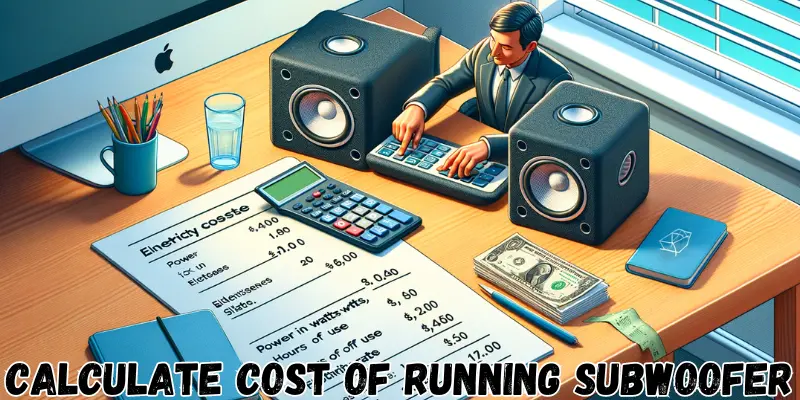
Curious about what your subwoofer is adding to your electricity bill? It’s simpler than you might think to figure this out. All you need is a basic formula and some information about your subwoofer and how you use it.
Let’s break down how to calculate the cost of running your subwoofer, so you can enjoy your beats without worrying about the beatdown on your wallet.
The Simple Formula
To calculate the electricity cost of operating your subwoofer, you can use the following formula:
Cost=(Power in Watts×Hours of Use)/1000×Electricity RateCost=(Power in Watts×Hours of Use)/1000×Electricity Rate
Where:
Examples with Different Scenarios
Let’s go through a couple of examples to see how this works in real life:
Scenario 1: The Casual Listener
- Power Consumption: 100 Watts
- Hours of Use per Day: 2
- Electricity Rate: $0.10 per kWh
\text{Cost} = (100 \times 2) / 1000 \times 0.10 = $0.20 \text{ per day}
If you’re a casual listener, using your subwoofer for about 2 hours a day, it’ll cost you around $0.20 per day.
Scenario 2: The Movie Marathoner
- Power Consumption: 150 Watts
- Hours of Use per Weekend: 8 (4 hours each for Saturday and Sunday)
- Electricity Rate: $0.12 per kWh
\text{Cost} = (150 \times 8) / 1000 \times 0.12 = $1.44 \text{ per weekend}
For those weekends when you can’t get enough of your home theater, running your subwoofer for 8 hours will cost you $1.44.
These examples show how varying your subwoofer’s power consumption and your listening habits can affect the cost. By understanding these factors, you can make informed decisions about your subwoofer use without missing a beat on managing your energy expenses.
Whether you’re a casual listener or a dedicated cinephile, keeping tabs on your subwoofer’s power usage can help ensure that your audio adventures remain as cost-effective as they are captivating.
Tips for Reducing Subwoofer Power Consumption
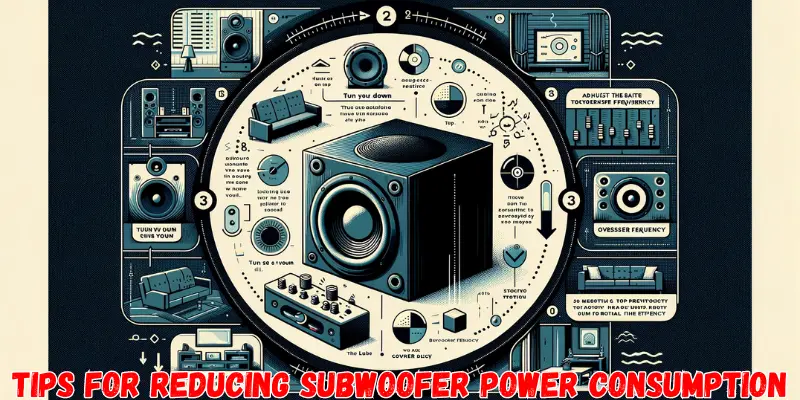
We all love the deep, immersive sound that subwoofers add to our music and movies, but no one is a fan of high electricity bills. Fortunately, there are ways to enjoy your subwoofer without letting it ramp up your energy costs.
Let’s explore some practical tips to reduce your subwoofer’s power consumption without compromising on sound quality, along with the benefits of opting for energy-efficient models.
Optimize Subwoofer Settings
Choose Energy-Efficient Subwoofers
Benefits of Energy-Efficient Subwoofers
Incorporating these tips into your subwoofer use and selection process can lead to significant energy savings without sacrificing the deep, rich sound that enhances your audio experience.
By being mindful of how we use and choose our subwoofers, we can all enjoy our favorite tunes and movies in an eco-friendly and cost-effective way.
Conclusion on How Much Power Does Subwoofer Use
In exploring How Much Power Does Subwoofer Use, we’ve uncovered the various factors that influence its power consumption, from usage patterns and subwoofer efficiency to the impact of room size and acoustics.
Understanding these elements is crucial for anyone looking to optimize their audio experience without incurring excessive electricity costs.
The importance of being mindful of a subwoofer’s power consumption extends beyond just the financial implications; it also has a significant environmental impact.
By choosing energy-efficient subwoofers and employing strategies to reduce power usage, we contribute to a more sustainable planet while enjoying our favorite sounds.
I encourage you, the reader, to apply the practical tips shared in this article to manage your subwoofer’s power usage effectively. Not only will this help in reducing your electricity bills, but it will also ensure you are part of the effort towards a more energy-efficient and environmentally friendly audio experience.
FAQs: How Much Power Does Subwoofer Use
Does using a subwoofer at lower volumes significantly reduce power usage?
Yes, using a subwoofer at lower volumes can significantly reduce its power consumption. Lower volume levels require less energy to produce sound, which can help in reducing your electricity usage and bills.
How much power does a subwoofer need?
The power a subwoofer needs can vary widely depending on its size, design, and efficiency. Typical home subwoofers might use anywhere from 100 to 500 watts under normal listening conditions, with some models requiring more or less depending on their specifications.
Are there any subwoofer brands known for energy efficiency?
Yes, there are several brands that prioritize energy efficiency in their subwoofers, including but not limited to, Energy Star-rated models from brands like Polk, Yamaha, and Sony. These brands often feature subwoofers that are designed to provide high-quality sound while minimizing power consumption.
How does subwoofer power consumption compare to other home appliances?
Subwoofer power consumption is generally lower than many large home appliances like refrigerators, air conditioners, and electric ovens, which can use thousands of watts. However, compared to smaller devices like laptops or LED lights, subwoofers can use more power, especially at higher volume levels or during extended use periods.







